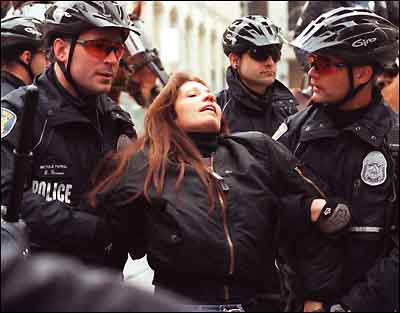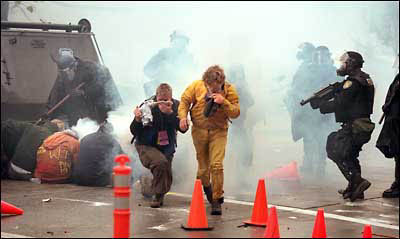|
the WTO Protests in Seattle Business unchecked becomes crime. One of the most significant milestones of the environmental movement in some time occurred back in late November and early December when 40,000 to 60,000 environmentalists, human rights activists, indigenous people, labor activists, fair trade proponents, people of faith, steelworkers and other union workers, farmers, students, and teachers representing more than 700 organizations took to the streets of Seattle to protest against the World Trade Organization at its Third Ministerial meeting. 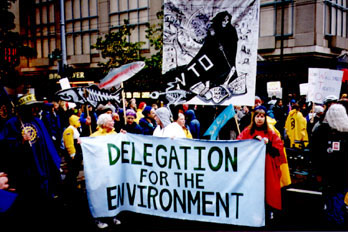 The protesters went to Seattle to alert the peoples of the world to the serious problems of the WTO and to send a strong message to the WTO itself that its practices were completely unacceptable. Their chant, "This is what democracy looks like", could be heard throughout the Seattle streets near the convention center where the WTO meetings were held. If the police had come up with a chant of their own it might have been, "This is what the official response to democracy looks like." 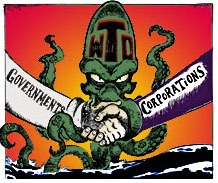 Established in 1995, the World Trade Organization (WTO) is the international institution that implements and enforces the rules that govern over 80% of world trade. It is also one of the world's most powerful, secretive, undemocratic and dangerous bodies and the principal rule-making bureaucracy of corporate-driven economic globalization. While its proponents say that it is based on "free trade", in fact, the WTO's 700 plus pages of rules, written by and for corporations, set out a comprehensive system of corporate-managed trade. It has transformed the General Agreement on Tariffs and Trade (GATT) into an enforceable global commercial code that serves only the interests of multinational corporations. If you haven't given much thought to the WTO before, that's just the way the member nations want it. The WTO is quickly emerging as a de facto global government for the "free trade" era. The WTO's goal is to increase international trade, not protect the environment or public health, and it works towards this goal by striving to diminish the regulatory powers of nation-states and local communities - particularly our rights to make laws about public health, food safety, environment, labor, culture, democracy and sovereignty - while increasing the powers and freedoms of global corporations to act without any controls. The WTO's decisions affect everyone and every area of daily life.  Trampling over human rights and the environment, the WTO prioritizes trade and commercial considerations over all other human values. WTO rules generally require domestic laws, rules and regulations designed to further worker, consumer, environmental, health, safety, human rights, or other non-commercial interests to be undertaken in the "least trade restrictive" fashion possible. Through these rules the organization is being used by multinational corporations to dismantle hard-won environmental protections and labor standards around the world. The WTO also undermines democracy, with its rules drastically shrinking the choices available to democratically controlled governments, and with violations potentially punished with harsh penalties. Operating in secrecy, its tribunals rule on the "legality" of nations' laws and whether or not they are "barriers to trade", carrying out their work behind closed doors. 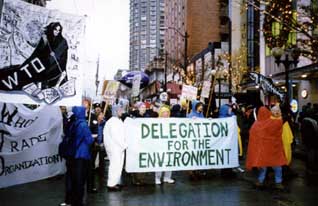 Some of these problems, such as the WTO's penchant for secrecy, could potentially be fixed, but the core problems - prioritization of commercial over other values, the constraints on democratic decision-making and a strong bias against local economies - cannot, for they are inherent in the WTO itself. While the vast majority of the protesters went to Seattle with a strong commitment to practice non-violent direct action, what they encountered from the police was anything but non-violence. The groups who organized the protests met with Seattle police officials prior to the WTO meetings and received a promise that officers would not attack protesters unless they were provoked. But after the demonstrators successfully blocked the opening ceremonies of the meetings on Monday, November 29th, serious police violence against them erupted on Tuesday morning when the police fired the first seven canisters of tear gas into the crowd. 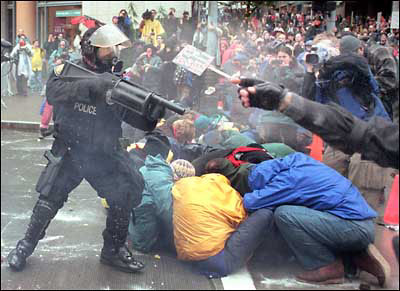 The "Battle of Seattle" had begun, and for the rest of the day and on into the night, the police attacked indiscriminately with tear gas, pepper spray, riot batons, concussion grenades, and plastic bullets. Veterans of Vietnam and civil rights protests of the 60's and many others who had participated in demonstrations and protests throughout the Third World reported that the violence perpetrated by the police against the demonstrators was the worst they had ever witnessed anywhere. Pepper-spray victim and writer Paul Hawken reports, "When I was able to open my eyes, I saw lying next to me a young man, 19, maybe 20 at the oldest. He was in shock, twitching and shivering uncontrollably from being tear-gassed and pepper-sprayed at close range. His burned eyes were tightly closed, and he was panting irregularly. Then he passed out." 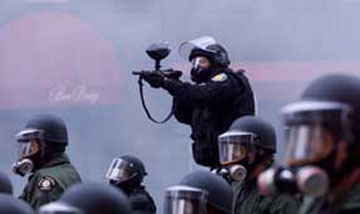 According to Hawken, "Tear gas, plastic bullets and pepper spray were used so frequently that by late afternoon, supplies ran low. What seemed like an afternoon lull or standoff was because police had used up all their stores....As police restocked, the word came down from the White House to secure downtown Seattle or the WTO meetings would be called off. By late afternoon, the Mayor and Chief of Police announced a 7 p.m. curfew, "no protest" zones, and declared the city under civil emergency (and the governor called in the Army National Guard)... Over the next seven hours and into the night, the police turned downtown Seattle into Beirut." In the words of Michael Meacher, environment minister of the United Kingdom, "What we hadn't reckoned with was the Seattle Police Department who single-handedly managed to turn a peaceful protest into a riot." 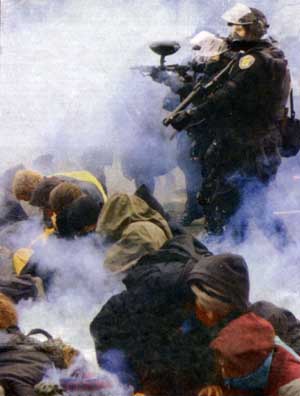 protesters Tuesday outside the WTO conference in Seattle. Mayor Paul Schell declared a civil emergency and placed most of downtown under curfew. In their defense, the police said that they were not prepared for the level of violence they encountered, and, predictably, the news media focused their attention on the protesters engaged in breaking windows and spraying graffiti on stores such as Starbucks and McDonalds. In reality, however, only a very, very small number of the tens of thousands of protesters engaged in this sort of property destruction. Moreover, all the people I have interviewed who attended the demonstrations reported the situation very differently from the way it was depicted by the mainstream media. They all reported that the police violence broke out BEFORE any of the window-smashing began (four hours before), not in response to it, and this was confirmed by the Seattle Police. Also, the police were widely witnessed to have stood back and let the vandals run amok. The protesters reported that the police largely ignored the vandals, focusing instead on the non-violent protesters who were making easier targets of themselves. As one protester later commented, what the police were unprepared for was a network of non-violent protesters totally committed to one task - shutting down the WTO. 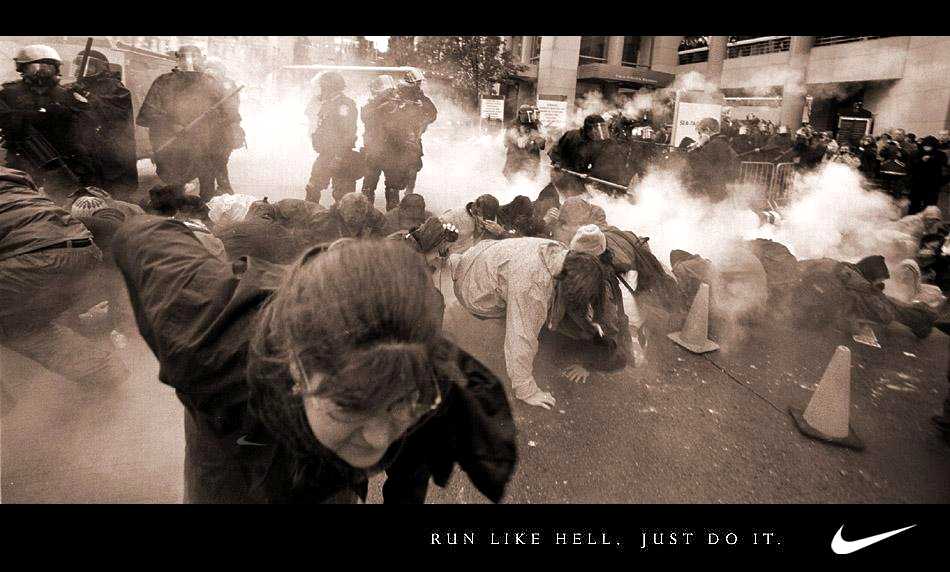 Tuesday was by far the worst day, but the police brutality and the arrests of demonstrators continued throughout the week, and as events continued the list of police atrocities grew.... without provocation police kneed and kicked protesters in the groin; they yanked back the heads of protesters sitting on the ground and sprayed them directly in each eye with pepper-spray; they used their thumbs to grind the eyes of pepper-spray victims; Seattle residents well outside of the "no protest" zone and not at all connected to the demonstrations were run down by the police, beaten and pepper-sprayed; members of the press who identified themselves to the police were still beaten and pepper-sprayed; they tear-gassed and brutalized people sitting in cafes; people were arrested well outside the "no-protest" zone simply for wearing anti-WTO buttons; arrested demonstrators who refused to give their names (their legal right) were beaten and tortured until they relented; lawyers were denied access to protesters in custody, and many of those held were not given food or water. 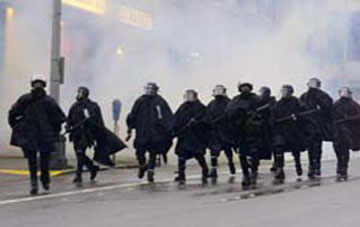 One eyewitness, non-violence trainer Matt Guynn, distributed the following account of police brutality over the Internet: "In one scene I witnessed this morning, police who had been standing behind a blockade line began marching in lock-step toward the line (of protesters), swinging their batons forward, and when they reached the line they began striking the nonviolent, seated protesters repeatedly in the back. Then they ripped off the protesters' gas masks, and sprayed pepper spray at point-blank range into their eyes repeatedly. After spraying, they rubbed the protesters' eyes and pushed their fingers around on their lips to aggravate the effect of the spray. And after all this, they began striking them again with batons." Another protester reported, "The police continued their attack even against people who were lying on the ground, totally disabled and extremely sick....It was as if the police were exterminating insects." Seattle physician Richard DeAndrea reported, "They were using rubber bullets. Some of the damage I saw from these rubber bullets...they took off part of a jaw, smashed teeth...There are people who have been...treated for plastic bullet wounds. Lots of tear gas injuries, lots of damage to the cornea, lots of damage to the eyes and skin." 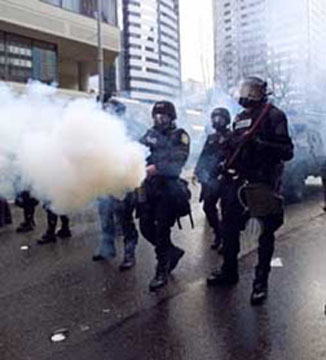 Shannon Wright, a campaign director for the Rainforest Action Network, says she was walking Wednesday morning several blocks outside the "no-protest" zone when two undercover officers grabbed her from behind, threw her to the ground and handcuffed her. The officers then did the same to three other people in the street, she said. They were charged with criminal trespassing and failure to disperse and taken to the Sand Point Naval Station, where many of the protesters are being held, and kept there overnight. Wright, though, says she had not criminally trespassed nor failed to disperse. "I was completely innocent," Wright said. "These cops are clearing the area of anyone who looks like a protester. I was targeted because I was wearing Gore-Tex and fleece, and that has become a crime in Seattle." Wright said she was never read her rights. She also says she witnessed police officers - for no apparent reason - pepper spray a group of 15 women sitting in a holding area from just three feet away. Wright says she's participated in protests in some of the most unsettled countries in the world - including Ecuador, Peru, Colombia and South Africa - and has never been treated so horribly. "I have never seen any sort of response like this," she said. "I have never witnessed anything like this anywhere around the world." Predictably, the corporate-owned media glossed
over and demonstrated a poor understanding of the important issues
raised by the protesters. They treated the protesters' concerns
with indifference and often contempt. They also inaccurately
depicted them as anti-trade, or linked to right wing extremists
like Pat Buchanan. As one observer commented, "Most of what
has been written is so inaccurate that I can't decide if the
reporters in question should be charged with conspiracy or simply
incompetence." Many questions remain. Did the police have instigators mixed in with the protesters as they did during the Vietnam era protests? As one protester reported, " I believe the police had their own people in there encouraging people to break stuff...I saw supposed protesters - they were screaming and so on - and then later, when everything was over, the same people tackled other protesters and put handcuffs on them." Did police instigators engage in vandalism to provide a rationale for the extensive use of violence by the authorities?
Another very important question remaining is whether or not some type of nerve toxin/cholinesterase inhibitor was used on the protesters in addition to the tear gas and pepper spray? What we do know is that 1) medical personnel providing first aid to the protesters identified a subset of casualties with symptoms consistent with exposure to neurotoxins and inconsistent with the pattern of symptoms attributable to tear gas and pepper spray; 2) the victims showing the atypical symptoms came from just two locations on the evening of December 1st; 3) some individuals exposed in the Pike Place Market area reported that the aforementioned pattern of symptoms came immediately after exposure to a non-irritating agent which did not cause the pain or burning of the tear gas and pepper spray; 4) the Seattle Police Department had to replenish its chemical weapons stocks by going to outside sources; 5) the Wyoming Air National Guard flew 3,300 pounds of "civilian riot control munitions" to Seattle; 6) various individuals have reported being told by individual law enforcement officers that "chemical weapons in addition to OC, CS, and CN (tear gas and pepper spray) were deployed"; and 7) U.S. Army Special Forces chemical warfare experts were on hand in Seattle. Regardless of what else happens, the one outcome of Seattle that seems certain is that the next meeting of the WTO will not be held in some U.S. city, but in some place like Jakarta or Singapore where the police and security forces will not be limited to the use of plastic bullets. The WTO is one of the most important issues facing environmental and human rights activists today. The organization's rules have an impact on all our lives. For anyone with access to the internet, there is abundant information about the WTO out there. I urge you to inform yourself and get involved. Some of the key websites to check are: Public Citizen/Tradewatch - http://www.tradewatch.org Other Articles About the WTO in this Issue Global Free Logging: Defend Our Forests - Clearcut the WTO What Will Be Next - The WTO's Anti-Environmental Record Top 10 Reasons to Oppose the World Trade Organization |
